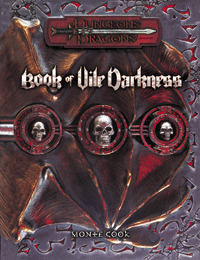
Ravenloft is a campaign setting for the Dungeons & Dragons roleplaying game. It is an alternate time-space existence known as a pocket dimension or demiplane, called the Demiplane of Dread, which consists of a collection of land pieces called "domains", brought together by a mysterious force known only as the Dark Powers. Each domain is tailored to and mystically ruled by a being called a Darklord who is forever trapped and surrounded by magical mists surrounding the domain. Strahd von Zarovich, a vampire in the original AD&DRavenloft I6 module released in 1983, became the first Darklord, both ruler and prisoner of his own personal domain of Barovia. The story of how Count von Zarovich became Darklord of Barovia was detailed in the 1993 novel I, Strahd: The Memoirs of a Vampire. As originally established in the Ravenloft: Realm of Terror boxed set known as "the Black Box" released in 1990, the Ravenloft campaign setting was located in the Ethereal Plane. As a physical manifestation of that plane, lands, monsters and even people were created out of the mysterious mists, and the realm acted as a prison where one could enter or be transported, but means of escape were few. Other Ravenloft Domains and Darklords were eventually added in various AD&D 2nd edition products establishing a core continent attached around Barovia which could be traveled to by others if their respective lords allowed entering or leaving their borders; while some Domains remained isolated in the mists and were referred to as Islands.
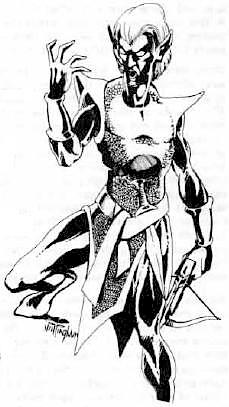
The drow or dark elves are a dark-skinned and white-haired subrace of elves connected to the subterranean Underdark in the Dungeons & Dragons fantasy roleplaying game. The drow have traditionally been portrayed as generally evil and connected to the evil spider goddess Lolth. However, later editions of Dungeons & Dragons have moved away from this portrayal and preassigned alignment. More recent publications have explored drow societies unconnected to Lolth.

Dragon is one of the two official magazines for source material for the Dungeons & Dragons role-playing game and associated products, along with Dungeon.
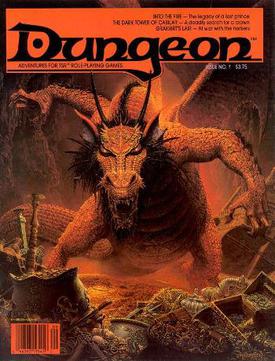
Dungeon was one of the two official magazines targeting consumers of the Dungeons & Dragons role-playing game and associated products; Dragon was the other.
Dragonlance is a shared universe created by Laura and Tracy Hickman, and expanded by Tracy Hickman and Margaret Weis under the direction of TSR, Inc. into a series of fantasy novels. The Hickmans conceived Dragonlance while driving in their car on the way to TSR for a job interview. Tracy Hickman met his future writing partner Margaret Weis at TSR, and they gathered a group of associates to play the Dungeons & Dragons role-playing game. The adventures during that game inspired a series of gaming modules, a series of novels, licensed products such as board games, and lead miniature figures.
The d20 System is a role-playing game system published in 2000 by Wizards of the Coast, originally developed for the 3rd edition of Dungeons & Dragons. The system is named after the 20-sided dice which are central to the core mechanics of many actions in the game.
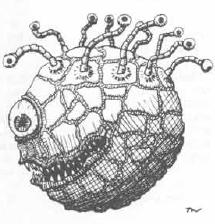
The beholder is a fictional monster in the Dungeons & Dragons fantasy role-playing game. It is depicted as a floating orb of flesh with a large mouth, single central eye, and many smaller eyestalks on top with powerful magical abilities.
A devil is a fictional classification of monsters in the Dungeons & Dragons roleplaying game. Often used as a high-level challenge for players of the game, devils are Lawful Evil in alignment and originate from the Nine Hells of Baator. In accordance with their Lawful Evil alignment, devils adhere to a rigid and ruthless hierarchy, undergoing transformations as they ascend the power structure. At the pinnacle of this hierarchy stand the mighty Archdevils, also known as the Lords of the Nine, who exercise dominion over distinct realms within Baator. Devils frequently view the myriad worlds in the D&D metacosmos as instruments to be manipulated for their own purposes, including waging the Blood War—a centuries-long conflict against their arch-foes, the demons.
The Underdark is a fictional setting which has appeared in Dungeons & Dragons role-playing campaigns and Dungeons & Dragons-based fiction books, including the Legend of Drizzt series by R. A. Salvatore. It is described as a vast subterranean network of interconnected caverns and tunnels, stretching beneath entire continents and forming an underworld for surface settings. Polygon called it "one of D&D's most well-known realms".

Ravenloft is an adventure module for the Dungeons & Dragons (D&D) fantasy role-playing game. The American game publishing company TSR, Inc. released it as a standalone adventure booklet in 1983 for use with the first edition Advanced Dungeons & Dragons game. It was written by Tracy and Laura Hickman, and includes art by Clyde Caldwell with maps by David Sutherland III. The plot of Ravenloft focuses on the villain Strahd von Zarovich, a vampire who pines for his lost love. Various story elements, including Strahd's motivation and the locations of magical weapons, are randomly determined by drawing cards. The player characters attempt to defeat Strahd and, if successful, the adventure ends.

Keith Baker is an American game designer and fantasy novel author. In addition to working with Wizards of the Coast on the creation of Eberron, he has also contributed material for Goodman Games, Paizo Publishing and Green Ronin Publishing. In 2014, Baker and Jennifer Ellis co-founded the indie tabletop game company Twogether Studios.
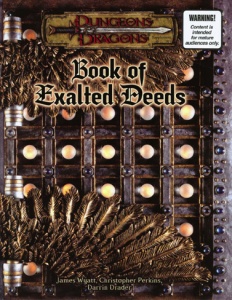
The Book of Exalted Deeds is an optional sourcebook for the 3.0 edition of the Dungeons & Dragons role-playing game published by Wizards of the Coast (WotC) in 2003. It provides supplementary game material for campaigns involving characters of good alignment. Within the game, there is also a powerful magical artifact of the same name.
In the Dungeons & Dragons fantasy roleplaying game, Tharizdun is the god of Eternal Darkness, Decay, Entropy, Malign Knowledge, Insanity, and Cold. He originated in the World of Greyhawk campaign setting but has since also appeared in other settings.

Iggwilv is a fictional wizard from the Greyhawk campaign setting for the Dungeons & Dragons roleplaying game. She was created by Gary Gygax.

In the Dungeons & Dragons fantasy role-playing game, goblins are a common and fairly weak race of evil humanoid monsters. Goblins are non-human monsters that low-level player characters often face in combat.
The Dungeons & Dragons (D&D) fantasy role-playing game has been adapted into many related products, including magazines, films and video games.
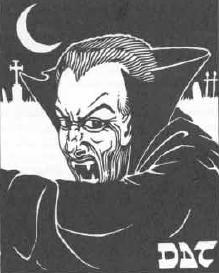
In the Dungeons & Dragons fantasy role-playing game, a vampire is an undead creature. A humanoid or monstrous humanoid creature can become a vampire, and looks as it did in life, with pale skin, haunting red eyes, and a feral cast to its features. A new vampire is created when another vampire drains the life out of a living creature. Its depiction is related to those in the 1930s and 1940s Hollywood Dracula and monster movies. In writing vampires into the game, as with other creatures arising in folklore, the authors had to consider what elements arising in more recent popular culture should be incorporated into their description and characteristics.

Robert J. Schwalb is a writer in the role-playing game industry, and has worked as a game designer and developer for such games as Dungeons & Dragons, A Song of Ice and Fire Roleplaying, Warhammer Fantasy Roleplay, and many other RPG supplements.
David Noonan is an author of several products and articles for the Dungeons & Dragons fantasy role-playing game from Wizards of the Coast.
